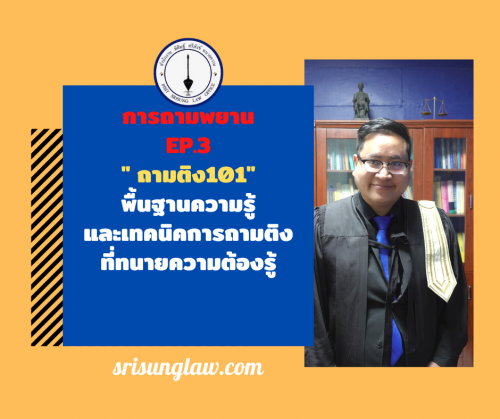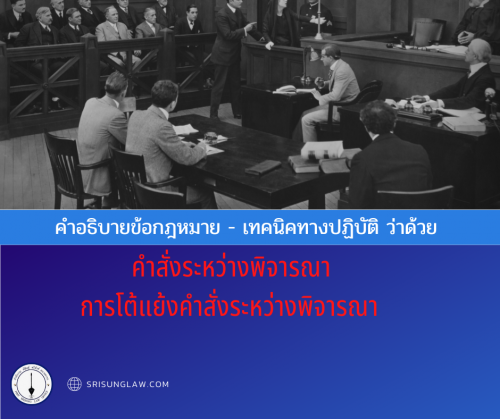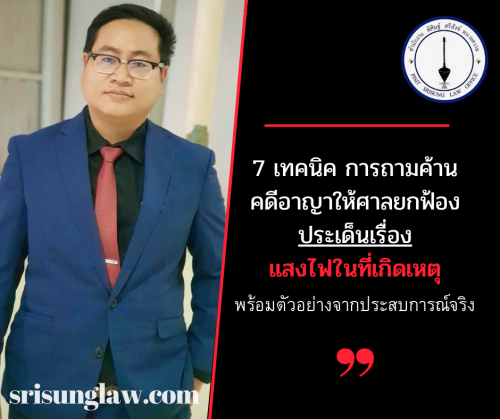การอ้างพยานเอกสาร เช่น สัญญาต่างๆที่ทำขึ้น ประกาศข้อความ หลักฐานการสนทนาผ่าน email LINE หรือ facebook messenger
หรือการอ้างพยานวัตถุ เช่น รูปถ่าย คลิปวีดีโอ คลิปเสียงสนทนา หรือวัตถุพยานอื่นที่เกี่ยวข้องกับคดี
หากฝ่ายใดต้องการจะอ้างพยานเอกสารหรือพยานวัตถุดังกล่าว เพื่อเป็นประโยชน์แก่คดีของตน ก็จะต้องยื่นบัญชีระบุพยานภายในเวลาที่กฎหมายกำหนด ทั้งนี้ไม่ว่าจะเป็นคดีแพ่งหรืออาญาก็ตาม
หากฝ่ายใดได้นำสืบพยานหลักฐานไปโดยไม่ได้ยื่นบัญชีระบุพยาน ศาลย่อมไม่อาจรับพยานหลักฐานดังกล่าวเข้าสู่สำนวน
หรือหากศาลเผลอเรอรับพยานหลักฐานดังกล่าวเข้าสู่สำนวนมา ศาลก็ไม่สามารถนำพยานหลักฐานมาวินิฉัยได้ (อ่านเรื่องการยื่นบัญชีระบุพยานแบบละเอียดได้ในบทความด้านล่าง )
ข้อยกเว้นไม่ต้องยื่นบัญชีระบุพยาน – พยานหลักฐานประกอบการถามค้าน
แต่อย่างไรก็ตาม หลักการอ้างอิงพยานเอกสารหรือพยานวัตถุจะต้องยื่นบัญชีระบุพยานก่อนนั้น มีข้อยกเว้นอยู่ประการหนึ่ง ซึ่งทนายความจะมีส่วนเกี่ยวข้องและจะได้ใช้บ่อย
และหากทนายความคนไหนเข้าใจหลักของข้อยกเว้นนี้ได้อย่างแจ่มกระจ่าง ก็จะสามารถนำมาปรับใช้ในการทำงานให้เกิดประโยชน์ได้เป็นอย่างดี
ข้อยกเว้นที่ว่าก็คือ หากพยานเอกสารหรือพยานวัตถุดังกล่าว ถึงเรายังไม่ได้ยื่นบัญชีระบุพยาน หรือเป็นกรณีที่เป็นเพียงชั้นไต่สวนมูลฟ้องที่เรายังไม่มีสิทธิอ้างพยานเอกสารหรือพยานวัตถุ
แต่หากพยานของฝ่ายตรงข้าม เบิกความรับรองพยานเอกสารหรือพยานวัตถุดังกล่าวแล้ว ศาลฎีกาก็ วินิจฉัยว่า ศาลในคดีดังกล่าวย่อมสามารถรับหลักฐานดังกล่าวสู่สำนวน และรับฟังพยานเอกสารหรือพยานวัตถุดังกล่าวได้โดยไม่ต้องยื่นบัญชีระบุพยาน
ตัวอย่างคำพิพากษาศาลฎีกา
คำพิพากษาศาลฎีกาที่ 850/2534
ในการสืบพยานจำเลยชั้นแรก พ.ผู้จัดการมรดกของร. อ้างตนเองเป็นพยานเบิกความว่า ที่ดินตามสำเนาโฉนดที่ดินตามเอกสารหมาย ล.4 ราคาประเมินตารางวาละ 2,500 บาท ตามหนังสือรับรองราคาประเมินเอกสารหมายล.1 โจทก์จึงอ้างหนังสือรับรองราคาประเมินเอกสารหมาย จ.6 มาหักล้างคำของพ.และข้อความตามหนังสือรับรองราคาประเมินเอกสารหมายล.1เมื่อพ.พยานจำเลยเบิกความรับรองหนังสือรับรองราคาประเมินเอกสารหมาย จ.6 ดังกล่าวโจทก์ย่อมมีสิทธิอ้างอิงหนังสือรับรองราคาประเมินเอกสารหมาย จ.6 เป็นพยานหลักฐานประกอบคำของ พ. โดยไม่ต้องยื่นบัญชีแสดงเอกสารต่อศาลได้คำพิพากษาศาลฎีกาที่ 2251/2536
ชั้นไต่สวนมูลฟ้อง ทนายจำเลยถามค้านตัวโจทก์ซึ่งอ้างตนเองเป็นพยานถึงเงินที่โจทก์รับไปจากจำเลย โดยเอาบันทึกที่โจทก์เซ็นรับเงินและเอกสารให้โจทก์ดูและโจทก์รับรองว่าถูกต้องแล้ว ทนายจำเลยจึงส่งบันทึกและเอกสารต่อศาล เช่นนี้ บันทึกกับเอกสารดังกล่าวไม่ใช่เป็นพยานเอกสารที่จำเลยอ้าง หากแต่เป็นเอกสารที่โจทก์เบิกความถึงและทนายจำเลยนำส่งศาลเพื่อประกอบถ้อยคำของโจทก์ให้ปรากฏรายละเอียดชัดเจนขึ้นเท่านั้น
คำพิพากษาศาลฎีกาที่ 3470/2538
การที่จำเลยมิได้ระบุหนังสือมอบอำนาจเป็นพยานและส่งสำเนาให้โจทก์แต่ใช้เอกสารนั้นประกอบการถามค้านโจทก์ว่า ล. เจ้าของกรรมสิทธิ์มอบอำนาจให้ ย. ทำสัญญาเช่ากับจำเลยพยานเอกสารดังกล่าวมิใช่เป็นพยานหลักฐานสนับสนุนข้ออ้างหรือข้อเถียงแม้จะมิได้ระบุไว้ในบัญชีพยานและส่งสำเนาให้โจทก์ก็ไม่ต้องห้ามมิให้รับฟังกรณีไม่อยู่ในบังคับประมวลกฎหมายวิธีพิจารณาความแพ่งมาตรา88,90ศาลรับฟังเอกสารดังกล่าวเป็นพยานได้ เมื่อจำเลยให้การต่อสู้ว่า ล. เจ้าของกรรมสิทธิ์มอบอำนาจให้ ย. ทำสัญญาเช่ากับจำเลยย่อมนำสืบโดยอ้างหนังสือมอบอำนาจเพื่ออธิบายให้เห็นว่าที่มีชื่อ ย. เป็นผู้ให้เช่าในสัญญาเช่าเพราะได้รับมอบอำนาจจาก ล. ไม่เป็นการนำสืบเปลี่ยนแปลงแก้ไขเอกสารสัญญาเช่า
คำพิพากษาศาลฎีกาที่ 7812/2547
ใบสั่งซื้อสินค้าเป็นเอกสารที่โจทก์ใช้ในการถามค้านจำเลยที่ 2 ที่อ้างตนเองเป็นพยาน เมื่อจำเลยที่ 2 เบิกความรับรองเอกสารนั้นแล้ว โจทก์จึงอ้างส่งเป็นพยานหลักฐานต่อศาลชั้นต้น จึงมิใช่พยานหลักฐานสนับสนุนข้ออ้างหรือข้อเถียงของโจทก์ แม้โจทก์จะไม่ได้ระบุเอกสารดังกล่าวไว้ในบัญชีระบุพยานของโจทก์ และมิได้ส่งสำเนาเอกสารดังกล่าวต่อศาลชั้นต้นก่อนวันสืบพยานไม่น้อยกว่า 7 วัน ก็ไม่ต้องห้ามมิให้รับฟัง กรณีไม่อยู่ในบังคับ ป.วิ.พ. มาตรา 88 และมาตรา 90 จึงรับฟังเอกสารดังกล่าวเป็นพยานได้
คำพิพากษาศาลฎีกาที่ 3770/2547
แม้จำเลยทั้งสามมิได้ระบุเอกสารหมาย ล.1 ถึง ล.4 เป็นพยานหลักฐานแต่ได้ใช้เอกสารเหล่านั้นประกอบการถามค้านโจทก์ที่ 1 ซึ่งอ้างตนเองเป็นพยานว่าโจทก์ที่ 1 ได้รับเงินที่จำเลยที่ 1 โอนให้แก่โจทก์ที่ 1 แล้วตามใบรับฝากเงินเอกสารหมาย ล.1 ทั้งโจทก์ที่ 1 เองก็เบิกความรับรองเอกสารหมาย ล.1 ถึง ล.4 โดยยืนยันว่าเป็นผู้ลงลายมือชื่อรับรองความถูกต้องเกี่ยวกับหลักฐาน การที่จำเลยที่ 1 ขายที่ดินพิพาทให้จำเลยที่ 2 ตามเอกสารหมาย ล.2 และ ล.3 จำเลยที่ 1 จึงอ้างเอกสารเหล่านั้นเป็นพยานหลักฐานประกอบคำเบิกความของโจทก์ที่ 1 ได้ กรณีไม่อยู่ในบังคับ ป.วิ.พ. มาตรา 88 และมาตรา 90 แม้เอกสารหมาย ล.1 ถึง ล.4 มิได้ระบุไว้ในบัญชีพยานและส่งสำเนาให้โจทก์ทั้งสอง ก็หาต้องห้ามมิให้รับฟังเอกสารดังกล่าวแต่อย่างใด
ผลของการที่พยานเบิกความรับรอง พยานเอกสารหรือพยานวัตถุ
หากเป็นคดีอาญาในชั้นไต่สวนมูลฟ้อง หากพยานโจทก์เบิกความรับรองพยานเอกสารหรือพยานวัตถุ ศาลก็สามารถรับเอกสารหรือวัตถุดังกล่าวเข้าสู่สำนวนเพื่อประกอบการพิจารณาได้
ซึ่งย่อมจะเป็นประโยชน์อย่างมากกับทนายความจำเลยในชั้นไต่สวนมูลฟ้อง เพราะเป็นการทำให้ศาลได้รับฟังข้อเท็จจริงและพยานหลักฐานจากฝั่งจำเลยเพิ่มเติม นอกจากการรับฟังข้อเท็จจริงจากฝ่ายโจทก์เพียงอย่างเดียว
หากเป็นคดีแพ่ง หรือคดีอาญาในชั้นพิจารณา ศาลก็สามารถรับเอกสารเข้าสู่สำนวนและรับฟังพยานหลักฐานดังกล่าวได้ โดยฝ่ายเราไม่ต้องยื่นบัญชีระบุพยานดังกล่าว
ซึ่งจะเป็นประโยชน์ในแง่ของการพิสูจน์พยานหรือจับเท็จพยาน โดยไม่ให้ฝ่ายตรงข้ามรู้ก่อนว่าเรามีพยานเอกสารหรือพยานวัตถุอะไรอยู่ในมือบ้าง
การที่เราจะใช้เทคนิคดังกล่าวได้อย่างถูกต้องเราจะต้องเข้าใจข้อกฏหมายดังกล่าวอย่างชัดเจน
ซึ่งหลักที่เราจะต้องเข้าใจให้แน่ชัดก็คือ อย่างไรถือว่าเป็นการเบิกความรับรองพยานเอกสารหรือพยานวัตถุ อย่างพยานวัตถุดังกล่าวอยู่จริง
อย่างไรถือเป็นการเบิกความรับรองพยานเอกสารหรือพยานวัตถุ
1.ยอมรับว่ามีเอกสาร/พยานวัตถุดังกล่าวอยู่จริง
ตัวอย่างเช่นพยานเบิกความตอบคำถามค้าน่าวว่า เอกสารดังกล่าวเป็นเอกสารของหน่วยงานราชการในสังกัดของตนเองจริง หรือ รูปถ่ายดังกล่าวเป็นรูปถ่ายของคนที่พยานรู้จัก หรือ คลิปวีดีโอดังกล่าว คือคลิปวีดีโอเหตุการณ์เกิดเหตุจริง
2.ยอมรับว่าเคยเห็นพยานเอกสาร-พยานวัตถุ มาก่อน
ตัวอย่างเช่น เบิกความตอบคำถามค้านว่า เคยเห็นหนังสือทวงถามหนี้ฉบับดังกล่าวมาก่อน หรือ เคยเห็นรูปถ่ายดังกล่าวมาก่อน หรือ เคยเห็นคลิปวีดีโอดังกล่าวมาก่อน
3.ยอมรับว่ามีลายมือชื่อตนเองในเอกสาร หรือมีตนเองอยู่ในคลิปหรือรูปถ่าย
ตัวอย่างเช่น เบิกความตอบคำถามค้านว่า ตนเองเป็นคนลงลายมือชื่อเป็นพยานในสัญญาจริง หรือ ตนเองเป็นคนถ่ายคลิปดังกล่าวจริง หรือ หลักฐานการสนทนาผ่านโปรแกรมไลน์นั้น เป็นของตนเองจริง
การเบิกความตอบคำถามค้านในลักษณะดังกล่าวเป็นการเบิกความรับรองพยานเอกสารหรือพยานวัตถุซึ่งทำให้ศาลสามารถรับพยานหลักฐานดังกล่าวเข้าสู่สำนวนและนำไปประกอบการวินิจฉัยคดีได้
อย่างไรไม่ถือว่าเป็นการเบิกความรับรองพยานเอกสารหรือวัตถุ
1.เบิกความว่า ไม่เชื่อว่าเอกสาร รูปถ่าย หรือคลิปดังกล่าวเป็นของจริง
ตัวอย่างเช่นพยานเบิกความตอบคำถามค้านว่า เอกสารดังกล่าวน่าจะเป็นเอกสารปลอมมีพิรุธ รูปถ่ายดังกล่าวน่าจะเป็นรูปตัดต่อ คลิปวีดีโอดังกล่าวน่าจะไม่เกี่ยวข้องกับเหตุการณ์ในคดี
2.เบิกความว่า ไม่เคยเห็น เอกสาร รูปถ่าย หรือ วัตถุดังกล่าวมาก่อน
ตัวอย่างเช่นพยานเบิกความตอบคำถามค้านว่า ไม่เคยพบเห็น สัญญาที่ทนายความนำมาถามค้านมาก่อน ไม่รู้ว่าจะเป็นของจริงหรือไม่ รูปถ่ายดังกล่าวพยานก็ไม่เคยเห็น ไม่รู้ว่าเป็นรูปของใคร วีดีโอที่ทนายความนำมาเปิดให้ดูก็ไม่เคยเห็นมาก่อน และไม่รู้ว่าเกี่ยวข้องกับคดีอย่างไร
3.ไม่ยอมรับว่าเอกสารมีลายมือชื่อตนเอง และไม่มีส่วนเกี่ยวข้องใดๆ ในรูปถ่ายหรือคลิปวีดีโอ
ตัวอย่างเช่น พยานเบิกความตอบคำถามค้านว่า สัญญาดังกล่าว พยานไม่ได้เป็นคนลงลายมือชื่อเป็นคู่สัญญา ไม่ได้ลงลายมือชื่อเป็นพยาน รูปถ่ายดังกล่าวพยานไม่ได้เป็นคนถ่าย และบุคคลหรือเหตุการณ์ที่อยู่ในรูปพยานก็ไม่รู้จักไม่เคยพบเห็นมาก่อน คลิปเสียงที่นำมาเปิดก็ไม่ใช่ของพยาน หลักฐานการสนทนาผ่านโปรแกรม LINE หรือ Facebook Messenger ที่นำมาถามค้านก็ไม่ใช่ของพยาน
ในกรณีที่พยานเบิกความตอบคำถามค้านในลักษณะดังกล่าว ถือว่าพยานไม่ได้รับรองพยานหลักฐานดังที่ทนายความนำมาถามค้าน ดังนั้นศาลจึงไม่มีสิทธิรับพยานหลักฐานดังกล่าวเข้าสู่สำนวนได้ หากศาลเผรอรับเข้าสู่สำนวนมาศาลก็ไม่สามารถรับฟังพยานหลักฐานดังกล่าวประกอบการวินิจฉัยคดีได้
สรุป
หากเราเป็นฝ่ายถามค้าน ก็ต้องพยายามนำเอาพยานเอกสารหรือพยานวัตถุไปถามค้านพยานให้พยานรับรองให้ได้ และขออ้างส่งเข้าสำนวน หากท่านผู้พิพากษาไม่ยอมรับก็ต้องชี้แจงได้
หากเป็นฝ่ายที่อ้างพยานเข้าสืบ ก็ต้องคอยดูว่า ตอนที่ทนายความฝ่ายตรงข้ามถามพยานของเรา พยานของเราได้เบิกความรับรองพยานหลักฐานหรือไม่ ถ้าพยานไม่รับรอง ศาลก็ไม่มีสิทธิรับเข้าสำนวน
ถ้าฝ่ายตรงข้ามพยายามจะขออ้างส่งเข้าสู่สำนวน เราก็จะต้องคัดค้านไม่ให้ศาลรับ หากศาลยังฝืนรับ เราก็ต้องทำคำแถลงโต้แย้งคัดค้านไว้
หากเราไม่คัดค้านให้ถูกจังหวะ บางครั้งพยานหลักฐานที่เราควรจะส่งได้ ก็ไม่ได้ส่งเข้าสู่สำนวน หรือบางครั้งพยานหลักฐานที่ไม่ควรจะเข้าสู้สำนวนก็จะเข้าสู่สำนวน งั้นอย่างที่เราทำความเข้าใจข้อกฎหมายเกี่ยวกับเรื่องนี้ให้กระจ่างแจ้งก็จะเป็นประโยชน์ในการทำงานเป็นอย่างมากครับ
หวังว่าบทความนี้จะเป็นประโยชน์แก่เพื่อนๆทนายความและผู้สนใจทั่วไป หากถูกใจก็รบกวนกดแชร์ และคอมเม้น เพื่อเป็นกำลังใจให้ผมนำเทคนิคการทำงานเช่นนี้มาเผยแพร่ต่อไปนะครับ ขอบคุณมากครับ

 51/29-51-30 หมู่ 4 ต.บ้านสวน อ.เมือง จ.ชลบุรี
51/29-51-30 หมู่ 4 ต.บ้านสวน อ.เมือง จ.ชลบุรี









